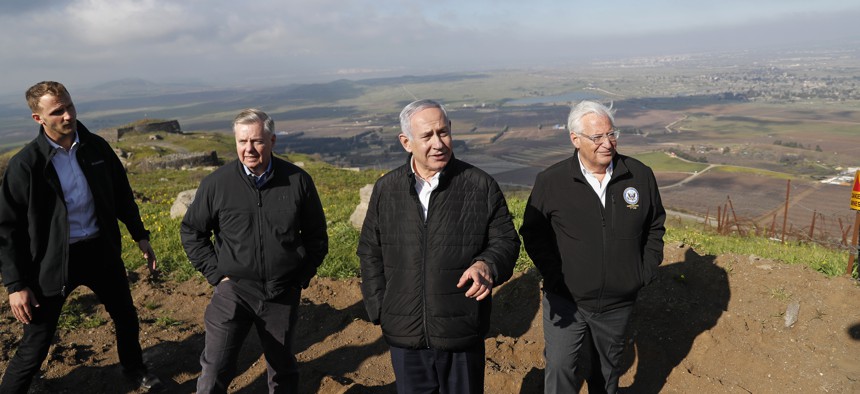
Israeli Prime Minister Benjamin Netanyahu, center, Republican U.S. Senator Lindsey Graham, second left, and U.S. Ambassador to Israel David Friedman, right, visit the border between Israel and Syria at the Israeli-held Golan Heights, March 11, 2019. Ronen Zvulun/Pool via AP
Trump's Golan Announcement Was No Impulse Tweet
The push for Trump to make such a move has been going on for more than a year, due to parallel efforts by Israeli officials and members of Congress.
Donald Trump once again overturned decades of U.S. policy via Twitter when he declared on Thursday that the United States should recognize Israeli sovereignty over the Golan Heights, a disputed territory Israel seized in the 1967 war with Syria. The area, he wrote, is “of critical strategic and security importance to the State of Israel and Regional Stability!”
The timing of the announcement, ahead of Israeli elections on April 9, drew immediate accusations that it was aimed to benefit Prime Minister Benjamin Netanyahu, who faces a competitive campaign as well as a looming indictmentover alleged corruption. Following the move of the U.S. embassy to Jerusalem last May, it was the second time Trump reversed long-standing U.S. positions on Israel, appearing to offer a major gift to the Israeli prime minister without any obvious concessions in return. Yet the push for Trump to make such a move has been going on for more than a year, due to parallel efforts by Israeli officials and members of Congress.
Texas Senator Ted Cruz was already drafting a plan to reinforce Israel’s control over the territory, which it effectively annexed in 1981, last summer. The rationale reported at the time had less to do with Israeli politics than with Iran, which was consolidating strength in Syria via its proxy Hezbollah and directly threatening Israel’s borders. At the same time, the issue was being discussed at the highest levels of the State Department and the National Security Council, according to Mark Dubowitz, who cowrote a February 2017 op-ed calling for the Golan recognition and was engaged in the discussions. The National Security Council would not comment on internal discussions, and the State Department did not immediately respond to a request for comment.
In the meantime, the Cruz plan was rolling along, and was introduced as a Senate resolution cosponsored by the Republican Tom Cotton in December. That was only days before Trump announced, also via tweet, his intention to withdraw U.S. troops from Syria. Trump has since partially reversed that policy and the administration now says it intends to keep around 400 troops in Syria.
And though U.S. troops’ stated mission there was the defeat of ISIS, Secretary of State Mike Pompeo has also said that the U.S. will stay until “every last Iranian boot” was out of Syria. The question of who would ensure this with the bulk of U.S. troops leaving, and how Iranian proxies could be kept from Israel’s borders, suddenly looked more urgent. In February Cruz, Cotton, and Representative Mike Gallagher introduced a bill to make it policy that the U.S. recognized the Golan Heights as part of Israel, though Israel’s annexation of that territory was never internationally recognized, and U.S. policy since the Reagan administration has not done so.
Senator Lindsey Graham, a cosponsor of the bill, went to the area with Netanyahu earlier this month. Netanyahu is also set to visit Trump next week, when the annual policy conference of the America Israel Public Affairs Committee takes place. He hailed Trump’s announcement on Twitter “at a time when Iran seeks to use Syria to destroy Israel.”
Much like with the embassy move, the announcement is awkward for Washington’s Western and Arab allies, whose support the administration will need when the White House unveils its long-awaited peace plan. The plan is expected to be unveiled sometime after the Israeli elections. A British Foreign Office spokesperson said, for example: “The UK views the Golan Heights as territory occupied by Israel. This has not changed.”
As for the Syrians, who are still in the midst of a civil war, the move is another blow. “It really puts the moderates in an impossible position,” Bassma Kodmani, a member of the negotiating team for the Syrian opposition, told The Atlantic. “If [Trump] is fighting Iran and radicalism, he thinks he’s just defeated Daesh [ISIS] and is containing and suffocating Iran ... I think he has just reversed that trend ... Assad will mobilize with the help of Iran and justify the presence of Iran, and the presence of militias, and the aggressive posture of Iran in the region,” she predicted. Syria’s mission at the United Nations did not respond to a request for comment.
Randa Slim, a senior fellow at the Middle East Institute, raised similar concerns, saying the move would eliminate any restraint Assad and Iran felt about allowing the Iranian Revolutionary Guard Corps freedom of maneuver near Israel’s border.
For the policy’s backers, however, declaring Israeli sovereignty over the Golan is a recognition of reality in the same way that Trump’s earlier decision to move the U.S. embassy to Jerusalem, was a recognition that the city is Israel’s capital despite its contested status. But it’s not just that. At a joint appearance with Secretary of State Mike Pompeo in Jerusalem this week, Netanyahu said the Israelis had just discovered efforts by Hezbollah to “build a terror network” in the territory. “And I can say that all of you can imagine what would have happened if Israel were not in the Golan,” he remarked. “I think it’s time that the international community recognize Israel’s stay in the Golan, the fact that the Golan will always remain part of the state of Israel.”
Just this morning, however, Pompeo demurred when asked if such a shift was imminent. A recent human rights report from the State Department had contained a telling shift in language, from referring to the Golan Heights as “Israeli-controlled” rather than “Israeli-occupied” as it had been in previous drafts. Asked about it, Pompeo said that the changed reference to the Golan Heights was deliberate, but did not signal a shift in policy. A few hours and less than 280 characters later, that shift seems to be happening.




